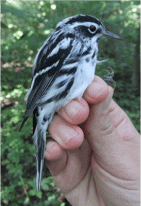
The number of warbler species banded and observed by PIBO dwindled steadily over the second half of the month of September, until by the 30th only a single Magnolia Warbler was banded. Earlier, there were still a few mixed flocks of migrating warblers moving through on September 17th, 19th, and 22nd, including Black-Throated Green Warblers, Black-and-White Warblers, Blackpoll Warblers and Tennessee Warblers, and Ovenbirds were seen on September 17th and 21st. As well, a handsome male Hooded Warbler was seen on census on September 21st and 22nd, hanging out around Fox Pond, and the first Myrtle Warbler of the season was seen on September 19th.
More sparrow species have been observed: the first White-Throated Sparrow was banded on September 18th, and one or two have shown up of a morning since then. On September 22nd, a White- Crowned Sparrow and a Savannah Sparrow were seen on census, which was the first sighting of either of these species for the season.
September 24th was a warm, clear day, and many Blue Jays were seen on census preparing to migrate south over the lake. (Unlike many songbirds, Blue Jays migrate during the day.) Flocks of hundreds of jays were seen consistently for the rest of the month, often being harassed by the Sharp-Shinned Hawks, Cooper’s Hawks and, on one occasion, a Peregrine Falcon that waited for the jays to move out over the lake before stooping on them and scattering the flock (a common hunting technique for falcons). Once the breeding season is over Blue Jays gather in large flocks to migrate south, but their migration is not as predictable as that of other birds. Banding records have shown that birds banded in the U.S. one winter are often found wintering in Canada in a subsequent year, which suggests that individual birds may migrate one year but not the next, perhaps in response to changes in their natural food supplies.
The first Brown Creeper of the season was banded on September 28th, and several more were seen on census and in the netting area the next day. Brown Creepers are year-round residents over most of their breeding range but in eastern Canada they migrate in the fall, sometimes moving as far south as North
Carolina and Arkansas. In the winter, Brown Creepers subsist mainly by feeding on hibernating insects concealed in the bark of trees. They forage by moving up tree trunks in a characteristic ‘hitching’ motion, using their stiff tail feathers as a support in a similar manner to woodpeckers, and can be very difficult to spot owing to their brown-and-grey plumage. They are often found in the company of kinglets, who have similar feeding habits, and indeed 20 Ruby-Crowned Kinglets were also spotted on September 29th.
And lastly (and rather unexpectedly), a large group of shorebirds migrated through on September 28th. Shorebirds generally migrate earlier than songbirds, and we had thought we’d just about seen the last of them when several Killdeers, two Black-Bellied Plovers and over thirty Sanderlings turned up at the tip on census. Perhaps the warm weather we’ve been enjoying had caused them to linger on their breeding grounds – in any case, we were very glad they stopped by!
